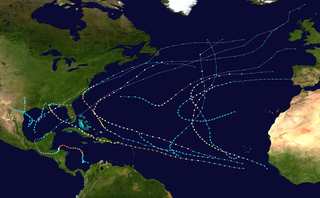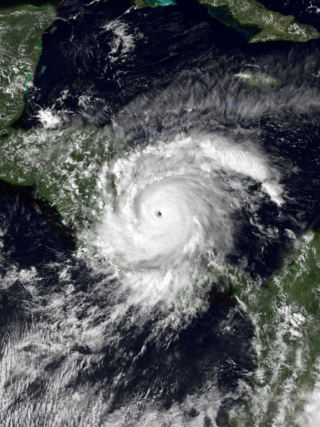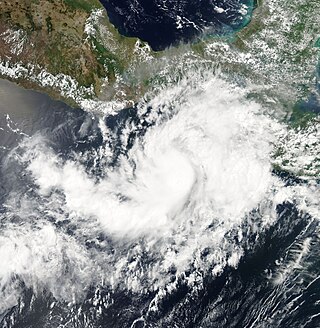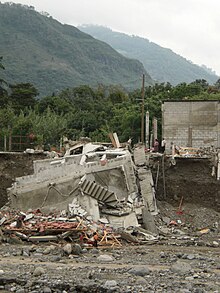
Hurricane Mitch was the second-deadliest tropical cyclone in the Atlantic basin on record. Mitch caused 11,374 fatalities in Central America in 1998, including approximately 7,000 in Honduras and 3,800 in Nicaragua due to cataclysmic flooding from the slow motion of the storm. It was the deadliest hurricane in Central American history, surpassing Hurricane Fifi–Orlene, which killed slightly fewer people in the same area in 1974. Mitch was the deadliest Atlantic hurricane in the satellite era, and the second-deadliest on record in the Atlantic, only behind the Great Hurricane of 1780 which killed at least 22,000 people.

The 1998 Atlantic hurricane season was a catastrophic and deadly Atlantic hurricane season, which had the highest number of storm-related fatalities in over 218 years and some of the costliest ever at the time. The season had above average activity, due to the dissipation of an El Niño event and transition to La Niña conditions. It officially began on June 1 and ended on November 30, dates which conventionally delimit the period during which most tropical cyclones form in the Atlantic Ocean. The season had a rather slow start, with no tropical cyclones forming in June. The first tropical cyclone, Tropical Storm Alex, developed on July 27, and the season's final storm, Hurricane Nicole, became extratropical on December 1.

The 1996 Atlantic hurricane season had the most major hurricanes since 1950, which are Category 3 or higher on the Saffir-Simpson scale. The season was above-average, featuring a total of thirteen named storms, nine hurricanes, and six major hurricanes. The season officially began on June 1, 1996 and ended on November 30, 1996, dates which conventionally delimit the period of each year when most tropical cyclones form in the Atlantic basin. The season's first tropical cyclone, Tropical Storm Arthur, developed on June 17, while the final cyclone, Hurricane Marco dissipated on November 26. The most intense hurricane, Edouard, was a powerful Cape Verde-type hurricane that affected portions of the Mid-Atlantic states and New England. The season featured nine tropical cyclone landfalls, including six hurricanes, one of which was a major hurricane. In total, six major hurricanes formed during the 1996 Atlantic hurricane season—the highest number produced in a single season since 1950.

The 1974 Atlantic hurricane season was a destructive and deadly hurricane season. In terms of overall activity, it was near average, with eleven named storms forming, of which four became hurricanes. Two of those four became major hurricanes, which are Category 3 or higher systems on the Saffir–Simpson scale. The season officially began on June 1 and lasted until November 30. These dates conventionally delimit the period of each year when most tropical cyclones form in the Atlantic Ocean.

Hurricane Keith was a tropical cyclone in October 2000 that caused extensive damage in Central America, especially in Mexico and Belize. It was the fifteenth tropical cyclone, eleventh named storm, and seventh hurricane of the 2000 Atlantic hurricane season. Keith developed as a tropical depression from a tropical wave in the western Caribbean Sea on September 28. The depression gradually strengthened, and became Tropical Storm Keith on the following day. As the storm tracked westward, it continued to intensify and was upgraded to a hurricane on September 30. Shortly thereafter, Keith began to rapidly deepen, and peaked as a Category 4 hurricane less than 24 hours later. Keith then began to meander erratically offshore of Belize, which significantly weakened the storm due to land interaction. By late on October 2, Keith made landfall in Ambergris Caye and Caye Caulker, Belize as a minimal hurricane. It quickly weakened to a tropical storm, before another landfall occurred near Belize City early on the following day. While moving inland over the Yucatán Peninsula, Keith weakened further, and was downgraded to a tropical depression before emerging into the Gulf of Mexico on October 4. Once in the Gulf of Mexico, Keith began to re-strengthen and was upgraded to a tropical storm later that day, and a hurricane on the following day. By late on October 5, Keith made its third and final landfall near Tampico, Tamaulipas, Mexico as a moderately strong Category 1 hurricane. The storm quickly weakened inland and dissipated as a tropical cyclone by 24 hours after landfall.

Hurricane Cesar–Douglas was one of the few tropical cyclones to survive the crossover from the Atlantic to east Pacific basin, and was the last to receive a new storm name upon doing so. Hurricane Cesar was the third named storm and second hurricane of the 1996 Atlantic hurricane season. The system formed in the southern Caribbean Sea and affected several countries in South America before crossing Nicaragua and entering the Eastern Pacific where it was renamed Hurricane Douglas, the fourth named storm, third hurricane, and first and strongest major hurricane of the 1996 Pacific hurricane season. The storm killed 113 people in Central and South America and left 29 others missing, mainly due to flooding and mudslides.

Hurricane Iris was a small, but powerful tropical cyclone that caused widespread destruction in Belize. Iris was the second-strongest storm of the 2001 Atlantic hurricane season, behind Hurricane Michelle. It was the ninth named storm, fifth hurricane, and third major hurricane of the year, forming from a tropical wave on October 4 just southeast of Barbados. It moved westward through the Caribbean, intensifying into a tropical storm on October 5 south of Puerto Rico, and into a hurricane on the following day. While passing south of the Dominican Republic, Iris dropped heavy rainfall that caused landslides, killing eight people. Later, the hurricane passed south of Jamaica, where it destroyed two houses. On reaching the western Caribbean Sea, Iris rapidly intensified into a Category 4 on the Saffir–Simpson scale. A small hurricane with an eye of only 7 mi (11 km) in diameter, Iris reached peak winds of 145 mph (233 km/h) before making landfall in southern Belize near Monkey River Town on October 9. The hurricane quickly dissipated over Central America, although its remnants contributed to the formation of Tropical Storm Manuel in the eastern Pacific Ocean. The hurricane caused severe damage—destroying homes, flooding streets, and leveling trees—in coastal towns south of Belize City.

Hurricane Joan was a long lived and powerful tropical cyclone that caused death and destruction in over a dozen countries in the Caribbean and Central America. Moving on a due west course for nearly two weeks in October 1988, Hurricane Joan caused widespread flooding and over 200 deaths after moving into Central America. Widespread suffering and economic crises were exacerbated by Joan, primarily across Nicaragua, as heavy rains and high winds impacted those near the hurricane's path.

Hurricane Fifi, later known as Hurricane Orlene, was a catastrophic tropical cyclone that killed over 8,000 people in Honduras in September 1974, ranking it as the third deadliest Atlantic hurricane on record, only behind Hurricane Mitch in 1998, and the 1780 hurricane. Fifi is also the first billion-dollar hurricane not to make landfall in the United States. Originating from a strong tropical wave on September 14, the system steadily tracked west-northwestward through the eastern Caribbean. On September 16, the depression intensified into Tropical Storm Fifi just off the coast of Jamaica. The storm quickly intensified into a hurricane the following afternoon and attained its peak intensity on September 18 as a strong Category 2 hurricane. Maintaining hurricane intensity, Fifi brushed the northern coast of Honduras before making landfall in Belize the following day. The storm quickly weakened after landfall, becoming a depression late on September 20. Continuing westward, the former hurricane began to interact with another system in the eastern Pacific.

The 2005 Atlantic hurricane season was the most active on record in terms of number of tropical cyclones, until surpassed by the 2020 season. It featured 28 tropical or subtropical storms. The United States National Hurricane Center named 27 storms, exhausting the annual pre-designated list, requiring the use of six Greek letter names, and adding an additional unnamed subtropical storm during a post-season re-analysis. A record 15 storms attained hurricane status, with maximum sustained winds of at least 74 miles per hour (119 km/h). Of those, a record seven became major hurricanes, rated Category 3 or higher on the Saffir–Simpson scale. Four storms of this season became Category 5 hurricanes, the most of any season on record.

Hurricane Stan was the deadliest tropical cyclone of the 2005 Atlantic hurricane season. A relatively weak system that affected areas of Central America and Mexico in early October 2005, Stan was the eighteenth named storm and eleventh hurricane of the 2005 season, having formed from a tropical wave on October 1 after it had moved into the western Caribbean. The depression slowly intensified, and reached tropical storm intensity the following day, before subsequently making its first landfall on the Yucatán Peninsula. While traversing the peninsula, the tropical storm weakened, but was able to re-intensify once it entered the Bay of Campeche. Under favorable conditions for tropical cyclogenesis, Stan attained hurricane strength on October 4, and later reached peak intensity with winds of 80 mph (130 km/h) and a minimum barometric pressure of 977 mbar (28.9 inHg). The hurricane maintained this intensity until landfall in the Mexican state of Veracruz later the same day. Once over the mountainous terrain of Mexico, however, Stan quickly weakened, and dissipated on October 5.

Hurricane Paul was a devastating tropical cyclone which killed a total of 1,625 people and caused US$520 million in damage, ranking it as the second deadliest Pacific hurricane on record, behind the 1959 Mexico Hurricane. The sixteenth named storm and tenth hurricane of the 1982 Pacific hurricane season, Paul developed as a tropical depression just offshore Central America on September 18. The depression briefly moved inland two days later just before heading westward out to sea. The storm changed little in strength for several days until September 25, when it slowly intensified into a tropical storm. Two days later, Paul attained hurricane status, and further strengthened to Category 2 intensity after turning northward. The hurricane then accelerated toward the northeast, reaching peak winds of 110 mph (175 km/h). Paul made landfall over Baja California Sur on September 29, and subsequently moved ashore in Sinaloa the next day.

Tropical Storm Barbara was the first tropical cyclone to make landfall during the 2007 Pacific hurricane season. The second storm of the season, Barbara developed from a small low-pressure area on May 29 about 235 miles (380 km) southeast of Acapulco, Mexico. The system drifted southward before turning to a steadily eastward motion, and quickly intensified into a tropical storm. Increased wind shear weakened Barbara, though it re-organized to attain peak winds of 50 mph (80 km/h) before moving ashore just west of the border of Mexico and Guatemala. It rapidly weakened over land, and on June 2 the National Hurricane Center discontinued advisories on the storm. Despite expectations that the storm would attain hurricane status, Barbara moved ashore as a small, weak tropical storm. It produced locally heavy rainfall and gusty winds, and in most locations damage was minor. However, in southern Mexico, the rainfall destroyed large areas of cropland, with crop damage totaling 200 million pesos. In El Salvador, four people were killed by storm-induced floods.

The 2010 Pacific hurricane season was the least active Pacific hurricane season on record, tied with 1977. The season accumulated the second-fewest ACE units on record, as many of the tropical cyclones were weak and short-lived. Altogether, only three of the season's eight named storms strengthened into hurricanes. Of those, two became major hurricanes, with one, Celia, reaching Category 5 intensity on the Saffir-Simpson scale. Despite the inactivity, however, it was the costliest Pacific hurricane season on record at the time, mostly due to Tropical Storm Agatha. The season officially began on May 15 in the eastern North Pacific and on June 1 in the central North Pacific. It ended in both regions on November 30. These dates, adopted by convention, historically describe the period in each year when most tropical cyclogenesis occurs in these regions of the Pacific. However, the formation of tropical cyclones is possible at any time of the year, as evidenced by the formation of Tropical Storm Omeka on December 19.

Hurricane Barbara was the easternmost landfalling Pacific hurricane on record. As the first hurricane of the 2013 Pacific hurricane season, Barbara developed from a low-pressure area while located southeast of Mexico on May 28. It headed slowly north-northeastward and strengthened into a tropical storm early on the following day. After recurving to the northeast, Barbara intensified into a Category 1 hurricane on May 29 and made landfall in Chiapas at peak intensity with winds of 80 mph (130 km/h) and a barometric pressure estimated at 983 mbar. When the hurricane made landfall, it was the second earliest landfalling hurricane in the basin since reliable records began in 1966. Barbara then moved across the Isthmus of Tehuantepec and dissipated within the mountainous terrain of Sierra Madre de Chiapas on May 30.

Tropical Storm Agatha was a weak but deadly tropical cyclone that brought widespread floods to much of Central America, and was the deadliest storm in the eastern Pacific tropical cyclone basin since Hurricane Pauline in 1997. The first named storm of the 2010 Pacific hurricane season, Agatha originated from the Intertropical Convergence Zone, a region of thunderstorms across the tropics. It developed into a tropical depression on May 29 and tropical storm later, it was dissipated on May 30, reaching top winds of 45 mph and a lowest pressure of 1000 mbar. It made landfall near the Guatemala–Mexico border on the evening of May 29. Agatha produced torrential rain all across Central America, which resulted in the death of one person in Nicaragua. In Guatemala, 152 people were killed and 100 left missing by landslides. Thirteen deaths also occurred in El Salvador. Agatha soon dissipated over Guatemala. As of June 15, officials in Guatemala have stated that 165 people were killed and 113 others are missing.

Tropical Storm Hermine was a near-hurricane strength tropical cyclone that brought widespread flooding from Guatemala northwards to Oklahoma in early September 2010. Hermine was the only known tropical cyclone to cross over into the North Atlantic basin in the satellite era. Though it was named in the western Gulf of Mexico, Hermine developed directly from the remnant low-pressure area associated with the short-lived Tropical Depression Eleven-E in the East Pacific. Throughout its lifespan, the storm caused 52 direct deaths and roughly US$740 million in damage to crops and infrastructure, primarily in Guatemala. The precursor tropical depression formed on September 3 in the Gulf of Tehuantepec and neared tropical storm intensity before making landfall near Salina Cruz, Mexico, on the next day. Though the depression quickly weakened to a remnant low, the disturbance crossed the Isthmus of Tehuantepec and tracked north into the warm waters of the Gulf of Mexico, where it reorganized into a tropical cyclone once again on September 5. There, the system quickly strengthened into a tropical storm and received the name Hermine before moving ashore near Matamoros, Mexico on September 7 as a high-end tropical storm. Over the next few days, Hermine weakened as it moved over the U.S. Southern Plains, eventually dissipating over Kansas on September 10.

Tropical Storm Matthew was a weak but deadly and destructive tropical cyclone which made landfall in Central America during the 2010 Atlantic hurricane season. The fifteenth tropical cyclone and thirteenth named storm of the year, Matthew formed on September 23 and lost its tropical characteristics in the morning of September 26. However, its remnants continued to produce life-threatening rain over parts of Central America as it dissipated.

The 2010 Guatemala City sinkhole was a disaster on 30 May 2010, in which an area approximately 20 m in diameter and 90 m deep collapsed in Guatemala City's Zona 2, swallowing a three-story factory. The sinkhole occurred because of a combination of reasons, including Tropical Storm Agatha, the Pacaya Volcano eruption, and leakage from sewer pipes. The sinkhole resulted in 1 death.

Tropical Storm Amanda and Tropical Storm Cristobal were two related, consecutive tropical cyclones that affected Central America, southern Mexico, the Central United States, and Canada in late May and early June 2020. The first tropical cyclone formed in the East Pacific and was named Amanda. After crossing Central America, its remnants regenerated into a second one in the Gulf of Mexico and was named Cristobal. Amanda was the second tropical depression and the first named storm of the 2020 Pacific hurricane season, and Cristobal was the third named storm of the extremely active 2020 Atlantic hurricane season, and the earliest third named storm in the North Atlantic Ocean on record. Cristobal's regeneration date in the North Atlantic eclipsed the date set by Tropical Storm Colin in 2016, which formed on June 5. It was also the first Atlantic tropical storm formed in the month of June since Cindy in 2017, and the first June tropical cyclone to make landfall in Mexico since Danielle in 2016.























